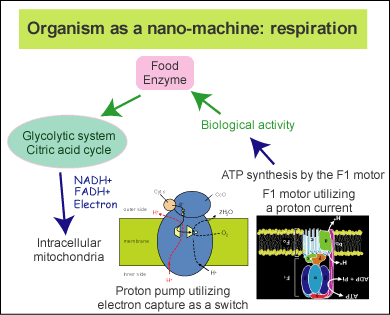II. Computational Bio-Sciences
II-1. High Performance Energy Transformation Mechanisms in a Living Body
In biomaterials, energy transformation is extremely efficient due to elaborate interactions between electrons and protons. Electronic transitions induce structural change in proteins, assist in proton transfer, and thus promote every type of enzyme reaction. For example, energy supporting life activities in a living body is saved as ATP, and is consumed as needed. ATP, which is like an internal battery, is typically created in the mitochondria in cells. Food and oxygen are passed through glycolytic processes, citric acid circuits, and then conveyed to mitochondria in the form of electrons and protons. Energy saved in electron systems is changed into a proton chemical potential difference, which is used in ATP synthesis by a proton motor. Microscopic individual processes, including electron transfer and capture, structural changes in a protein, and proton transfer, support life on Earth. Thus, these microscopic processes should be investigated using quantum theory.
Biomaterials consist of nuclei and electrons as nanomaterials do. Hence bioscience is a target of quantum theory. We aim to clarify microscopic mechanism of reactions in biomaterials by using the computational approach based on quantum theory.




